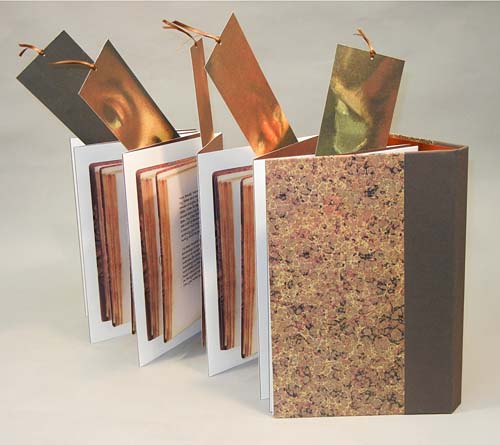|
|
|
The book is made up of five independent signatures each measuring 9 x 13.5" which have been sewn into an 11 x 15" accordion of BFK Rives paper. Each signature has a page-edge design from an actual Dégas sketchbook. The book is bound in boards covered with a reproduction of the endpapers from the same sketchbook.
|
|
|
|
Dégas's drawings of the period frequently used washes and stains as a way of modulating tones in his pencil drawings. This technique has been used in the imaginary drawings made to suggest the drawings Dégas might have made in response to Rome's challenges.The drawings in the style of Dˇgas have been reproduced as high resolution digital prints that have been accented with handwork in many instances.
|
|

|
Each of the five signatures has a slotted pocket in the back page which holds a card accessed by a ribbon pull. The card contains historical and cultural notes relating to the fictional diary entry.
|
|
|
The back of each card contains a horizontal slice of a Dégas self-portrait done in oil on paper in 1857. The pieces can be laid out to form a complete picture of Dégas as he looked to himself at age 23.
The book is contained in a side-drop box which has on its cover a portion of the map of Rome featuring the location of the Caffe Greco where Dégas and his friends often met and the Villa Medici, the location of the French Academy.
|
|
|
Dégas seems to have been aware of the interior growth he was experiencing in his early twenties. Between 1854 and 1860 he made eighteen self-portraits that reveal a deeply introspective nature. Five of these self-portraits have been chosen to represent Dégas as he considers the challenges that his escort, the beautiful Rome, has set for him.
|
|
|
In May, 2012, I spent three weeks in Rome following Dégas's footsteps. It was easy to find the way. He became such a prominent artist in later life that his tracks as a youth were easy to uncover because of the work of numerous historians and curators.
My visit to Rome opened my eyes to the importance of the City as an incubator for artistic insight, experience and joy. The twenty-three year old Dégas must have felt the same magic. The imaginary diary that I have written comes from the experience of standing where he stood. So much of what he saw is still there. For example, I sat at a table in the loggia of the Villa Farnesina in front of the Raphael painting of Galatea and sketched it from the same distance and perspective Dégas did 150 years earlier.
|